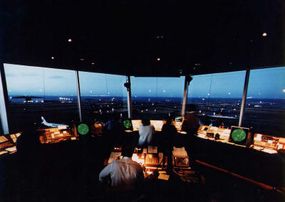
Once you've landed, the local controller directs your plane to an exit taxiway, tells your pilot the new radio frequency for the ground controller and passes your plane off to the ground controller.
The ground controller watches the runways and taxiways and uses ground radar information to ensure that your taxiing aircraft does not cross active runways or interfere with ground vehicles. He or she directs your plane to the appropriate terminal gate. Ground personnel from the airline use hand signals to assist your pilot in parking the airplane at the gate.
Careers and Concerns
What does it take to be an air traffic controller? To be a ground controller, you have to memorize the position of aircraft on the runways and taxiways with a single, short glance. Local, TRACON and ARTCC controllers must be able to think and visualize in three dimensions. All controllers must be able to gather information from what they hear, make decisions quickly and know the geography of their own airspace, as well as that of others. They must be able to read and interpret symbols as well as predict the whereabouts of aircraft from course headings and speeds, and they must be able to concentrate intensely. To test your skills as an air traffic controller, see pages 17 through 67 of the "Gate to Gate" CD ROM: Student Activity and Career Guidance Package.
Air traffic controllers at all levels are employed by the FAA. To become an air traffic controller, you must apply through the federal civil-service system and pass a written test that assesses your abilities to perform a controller's duties. Abstract reasoning and 3-D spatial visualization are tested on the exam. Applicants must have three years of work experience, a four-year college degree or some combination of the two.
If you are accepted into the training program, you will attend the FAA Academy in Oklahoma City, Oklahoma, for seven months of training. While there, you will learn the air traffic control system, equipment, regulations, procedures and about aircraft performance. You will need to pass a final examination before you graduate.
After graduation, you will accumulate work experience at various sites across the country, from airport towers to ARTCCs. You must be certified for various positions, such as ground controller, associate radar controller and radar hand-off controller. You will be required to pass annual physical examinations, semi-annual performance examinations and periodic drug screenings. Air traffic control positions are highly competitive jobs, and the controller workforce is relatively young (most were hired after the air traffic controller strike in the 1980s, when President Ronald Reagan ordered that all striking controllers be fired).
Air Traffic Controllers